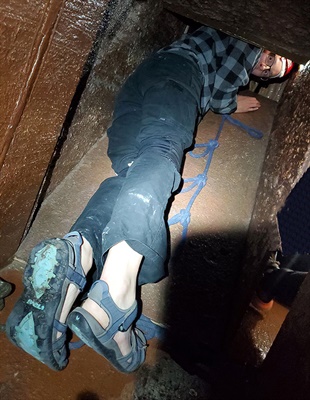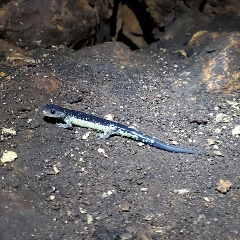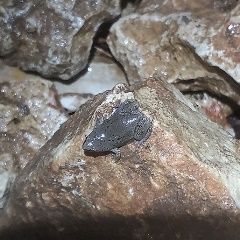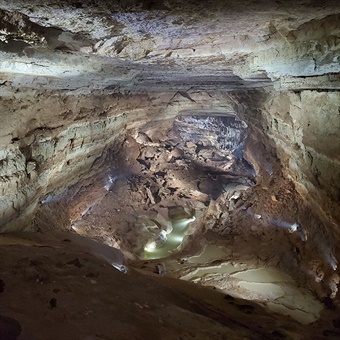Emily Roberts and Ryan Spotts, ANHC land management specialists, attended the 24th annual National Cave and Karst Management Symposium in San Marcos, Texas earlier this November. The event was hosted by Austin Water – Balcones Canyonlands Preserve and included participants from several states representing nonprofit organizations, government agencies, and private contracting companies.
 Though it rained for most of the day, one day of the symposium was dedicated to field trips. Spotts attended the trip titled, “From Recharge to Rivers: Groundwater Fauna Sampling Across Flowpaths,” and Roberts attended, “South Austin Wild Cave Tour: Management to Protect Cave Ecosystems.” The field trips provided an opportunity to see some local cave/spring features and learn from the people that manage them.
Though it rained for most of the day, one day of the symposium was dedicated to field trips. Spotts attended the trip titled, “From Recharge to Rivers: Groundwater Fauna Sampling Across Flowpaths,” and Roberts attended, “South Austin Wild Cave Tour: Management to Protect Cave Ecosystems.” The field trips provided an opportunity to see some local cave/spring features and learn from the people that manage them.
 During presentations the rest of the week, Roberts and Spotts learned cave management techniques that can be applied to caves found on ANHC natural areas. For example, a talk given by the founder of Bat Conservation International, Merlin Tuttle, detailed that vegetation management outside of bat-occupied caves is important. If there is too much vegetation near a cave entrance, bats may collide with branches or trunks when exiting the cave. Predators like snakes and raccoons may also use nearby vegetation as a tool to capture bats. Knowing this, ANHC staff will make a better effort to check on our natural areas’ major cave entrances and manage nearby vegetation in the future.
During presentations the rest of the week, Roberts and Spotts learned cave management techniques that can be applied to caves found on ANHC natural areas. For example, a talk given by the founder of Bat Conservation International, Merlin Tuttle, detailed that vegetation management outside of bat-occupied caves is important. If there is too much vegetation near a cave entrance, bats may collide with branches or trunks when exiting the cave. Predators like snakes and raccoons may also use nearby vegetation as a tool to capture bats. Knowing this, ANHC staff will make a better effort to check on our natural areas’ major cave entrances and manage nearby vegetation in the future.
 Several talks referenced data loggers that monitor temperature and carbon dioxide fluctuations within caves, which would be valuable to know for managing caves that harbor rare bat species. Other presentations mentioned the importance of surveying and inventorying cave features to get an idea of how to effectively manage the system. ANHC’s cooperative agreement with Cave Research Foundation has been instrumental in surveying and mapping cave elements on natural areas (read more about our partnership in this post: Partnership Discovers Caves on Natural Areas, Creates Maps).
Several talks referenced data loggers that monitor temperature and carbon dioxide fluctuations within caves, which would be valuable to know for managing caves that harbor rare bat species. Other presentations mentioned the importance of surveying and inventorying cave features to get an idea of how to effectively manage the system. ANHC’s cooperative agreement with Cave Research Foundation has been instrumental in surveying and mapping cave elements on natural areas (read more about our partnership in this post: Partnership Discovers Caves on Natural Areas, Creates Maps).
 Roberts and Spotts enjoyed learning more about cave and karst management, contemplating ways to improve ANHC’s cave and karst management, and connecting with professionals and academics who may be able to help the ANHC to better find, survey, and protect cave and karst features within our System of Natural Areas. They look forward to attending the 25th meeting of the symposium in 2023 and hope to be able to share ANHC’s progress over the intervening time.
Roberts and Spotts enjoyed learning more about cave and karst management, contemplating ways to improve ANHC’s cave and karst management, and connecting with professionals and academics who may be able to help the ANHC to better find, survey, and protect cave and karst features within our System of Natural Areas. They look forward to attending the 25th meeting of the symposium in 2023 and hope to be able to share ANHC’s progress over the intervening time.
Photos:
Top — ANHC Land Management Specialist Emily Roberts climbs through an artificial cave passage, trying to avoid bumping formations, in the cave simulation game called CaveSim.
Middle right — A western slimy salamander (Plethodon albagula). They are commonly found near cave entrances, but prefer damp habitats and retreat further underground during hot dry summers. Isolated populations of western slimy salamanders are being studied in southeastern Texas as there may actually be different species present. Photo by Emily Roberts.
Middle left — A western narrow-mouthed toad (Gastrophryne olivacea) that had likely fallen or was carried by water into the cave system. Photo by Emily Roberts.
Bottom — An overlook into an open cave passage at Natural Bridge Caverns. Photo by Emily Roberts.
 Though it rained for most of the day, one day of the symposium was dedicated to field trips. Spotts attended the trip titled, “From Recharge to Rivers: Groundwater Fauna Sampling Across Flowpaths,” and Roberts attended, “South Austin Wild Cave Tour: Management to Protect Cave Ecosystems.” The field trips provided an opportunity to see some local cave/spring features and learn from the people that manage them.
Though it rained for most of the day, one day of the symposium was dedicated to field trips. Spotts attended the trip titled, “From Recharge to Rivers: Groundwater Fauna Sampling Across Flowpaths,” and Roberts attended, “South Austin Wild Cave Tour: Management to Protect Cave Ecosystems.” The field trips provided an opportunity to see some local cave/spring features and learn from the people that manage them.  During presentations the rest of the week, Roberts and Spotts learned cave management techniques that can be applied to caves found on ANHC natural areas. For example, a talk given by the founder of Bat Conservation International, Merlin Tuttle, detailed that vegetation management outside of bat-occupied caves is important. If there is too much vegetation near a cave entrance, bats may collide with branches or trunks when exiting the cave. Predators like snakes and raccoons may also use nearby vegetation as a tool to capture bats. Knowing this, ANHC staff will make a better effort to check on our natural areas’ major cave entrances and manage nearby vegetation in the future.
During presentations the rest of the week, Roberts and Spotts learned cave management techniques that can be applied to caves found on ANHC natural areas. For example, a talk given by the founder of Bat Conservation International, Merlin Tuttle, detailed that vegetation management outside of bat-occupied caves is important. If there is too much vegetation near a cave entrance, bats may collide with branches or trunks when exiting the cave. Predators like snakes and raccoons may also use nearby vegetation as a tool to capture bats. Knowing this, ANHC staff will make a better effort to check on our natural areas’ major cave entrances and manage nearby vegetation in the future.  Several talks referenced data loggers that monitor temperature and carbon dioxide fluctuations within caves, which would be valuable to know for managing caves that harbor rare bat species. Other presentations mentioned the importance of surveying and inventorying cave features to get an idea of how to effectively manage the system. ANHC’s cooperative agreement with Cave Research Foundation has been instrumental in surveying and mapping cave elements on natural areas (read more about our partnership in this post: Partnership Discovers Caves on Natural Areas, Creates Maps).
Several talks referenced data loggers that monitor temperature and carbon dioxide fluctuations within caves, which would be valuable to know for managing caves that harbor rare bat species. Other presentations mentioned the importance of surveying and inventorying cave features to get an idea of how to effectively manage the system. ANHC’s cooperative agreement with Cave Research Foundation has been instrumental in surveying and mapping cave elements on natural areas (read more about our partnership in this post: Partnership Discovers Caves on Natural Areas, Creates Maps).  Roberts and Spotts enjoyed learning more about cave and karst management, contemplating ways to improve ANHC’s cave and karst management, and connecting with professionals and academics who may be able to help the ANHC to better find, survey, and protect cave and karst features within our System of Natural Areas. They look forward to attending the 25th meeting of the symposium in 2023 and hope to be able to share ANHC’s progress over the intervening time.
Roberts and Spotts enjoyed learning more about cave and karst management, contemplating ways to improve ANHC’s cave and karst management, and connecting with professionals and academics who may be able to help the ANHC to better find, survey, and protect cave and karst features within our System of Natural Areas. They look forward to attending the 25th meeting of the symposium in 2023 and hope to be able to share ANHC’s progress over the intervening time.Photos:
Top — ANHC Land Management Specialist Emily Roberts climbs through an artificial cave passage, trying to avoid bumping formations, in the cave simulation game called CaveSim.
Middle right — A western slimy salamander (Plethodon albagula). They are commonly found near cave entrances, but prefer damp habitats and retreat further underground during hot dry summers. Isolated populations of western slimy salamanders are being studied in southeastern Texas as there may actually be different species present. Photo by Emily Roberts.
Middle left — A western narrow-mouthed toad (Gastrophryne olivacea) that had likely fallen or was carried by water into the cave system. Photo by Emily Roberts.
Bottom — An overlook into an open cave passage at Natural Bridge Caverns. Photo by Emily Roberts.
